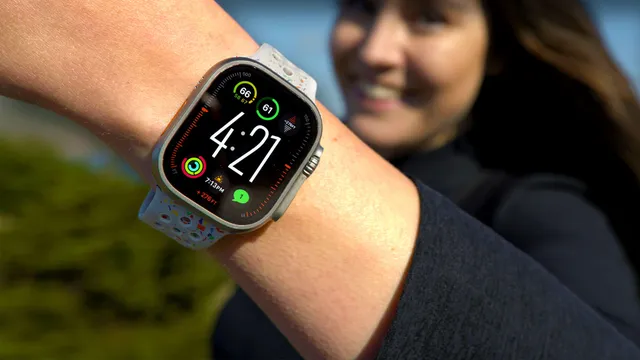Is It Safe to Wear a Smartwatch With a Pacemaker?
Imagine the convenience of having your heartbeat, steps, and other vital stats displayed right on your wrist. Smartwatches offer this incredible functionality, but what if you have a pacemaker or defibrillator?
You might wonder if these gadgets are safe to wear. This question is more than just a curiosity—it’s about your health and peace of mind. You deserve to know the facts before embracing the latest technology. You’ll discover whether smartwatches can safely coexist with your heart device, unravel myths, and get practical advice.
Keep reading to ensure that your health and tech can live harmoniously.
Pacemakers And Electromagnetic Interference
Wearing a smartwatch has become a common trend, but if you have a pacemaker or defibrillator, you might wonder about its safety. The main concern here is electromagnetic interference, which can potentially affect how these devices work. Understanding the relationship between pacemakers and electromagnetic interference is crucial to making informed decisions about your tech accessories.
How Pacemakers Work
Pacemakers are small devices implanted in the chest to help control abnormal heart rhythms. They send electrical pulses to prompt the heart to beat at a regular rate. Think of them as your heart’s personal rhythm coach, ensuring it stays in sync.
These devices monitor your heart’s activity and kick into action when they detect irregularities. They can be a lifesaver, literally ensuring your heart doesn’t miss a beat. However, their sensitivity to electrical signals makes them vulnerable to interference.
Sources Of Electromagnetic Interference
Electromagnetic interference (EMI) can come from various everyday sources. This interference can sometimes affect how pacemakers and defibrillators function. But what exactly are these sources?
- Household appliances:Microwaves, hairdryers, and electric shavers emit electromagnetic fields. While they are generally safe, standing too close while in use isn’t recommended.
- Electronic gadgets:Smartphones, tablets, and yes, smartwatches emit low-level electromagnetic fields. Most are designed to minimize interference, but caution is still advised.
- Medical equipment:MRI machines and certain diagnostic tools can interfere with pacemakers. Always inform medical staff about your device before undergoing any procedures.
So, is it safe to wear a smartwatch if you have a pacemaker or defibrillator? That depends on various factors, including the type of smartwatch and how it’s used. It’s crucial to consult with your healthcare provider for personalized advice.
Have you ever experienced interference with your pacemaker or defibrillator from an unexpected source? Understanding these interactions can help you make better choices about the technology you use daily.

Credit: avicennacardiology.com
Smartwatch Technology
Smartwatch technology raises concerns for those with pacemakers or defibrillators. Experts suggest consulting a doctor to ensure safety. Smartwatches might interfere with medical devices, so careful monitoring is crucial.
Smartwatches have become an integral part of our daily lives, offering a plethora of features that go beyond just telling the time. These innovative gadgets can track your fitness, monitor your heart rate, and even help you manage your schedule. But what if you have a pacemaker or defibrillator? Is it safe to wear a smartwatch in such a scenario? Understanding how smartwatch technology interacts with medical devices can help you make an informed decision.Functionality And Features
Smartwatches offer a range of functionalities designed to make your life easier. From receiving notifications to tracking your daily steps, they aim to keep you connected and active. Many smartwatches also include heart rate monitors, GPS, and sleep trackers, providing insights into your health. But these features often rely on emitting signals, such as Bluetooth or Wi-Fi, to communicate with other devices. While these emissions are generally low, it’s crucial to consider how they might interact with medical devices like pacemakers. Have you ever wondered if the constant buzz of notifications could affect your pacemaker? Understanding the technology is key to ensuring your safety.Common Emission Sources
Smartwatches emit various signals, primarily through Bluetooth, Wi-Fi, and sometimes NFC. These are essential for connecting your smartwatch to your smartphone or other devices. While the emissions are minimal, they are continuous. Do you know how close your smartwatch typically sits to your pacemaker? This proximity can influence the interaction between the two devices. Most manufacturers recommend maintaining a safe distance, usually around 6 inches, between your smartwatch and pacemaker. It’s important to note that not all smartwatches are created equal. Some models might emit stronger signals than others. Checking the specifications and guidelines provided by the smartwatch manufacturer can offer peace of mind. Understanding these emission sources and their potential impact allows you to enjoy the benefits of a smartwatch without compromising your health. After all, your safety should always come first.Potential Risks Of Smartwatches
Smartwatches offer modern convenience. They track health, manage notifications, and more. Yet, these devices might pose risks to some users. Especially those with pacemakers or defibrillators. The technology in smartwatches can interfere with these medical devices. Understanding these risks is crucial for safety. Let’s explore the potential dangers of wearing smartwatches with pacemakers or defibrillators.
Interference With Pacemakers
Pacemakers help maintain a regular heartbeat. They use electrical impulses to manage heart rhythms. Smartwatches also emit electromagnetic signals. These signals might disrupt pacemaker functions. The risk of interference varies among smartwatch models. It’s important to know how your specific device interacts.
Symptoms Of Interference
Interference can cause noticeable symptoms. Users may experience dizziness or lightheadedness. Chest pain might also occur. Some might feel their heart racing or skipping beats. These symptoms suggest a potential problem. If experienced, seek medical advice immediately. Monitoring your body’s responses is essential.
Research And Studies
Smartwatches may interfere with pacemakers or defibrillators. Studies suggest keeping a safe distance. Consult your doctor for personalized advice.
When considering the safety of wearing a smartwatch with a pacemaker or defibrillator, research and studies provide valuable insights. These devices are integral to heart health, and understanding their interaction with smartwatches is crucial. Let’s dive into the scientific findings and case studies that illuminate this topic.Scientific Findings
Recent studies have explored the electromagnetic fields generated by smartwatches. These fields can potentially interfere with pacemakers and defibrillators. However, research shows that the risk is minimal if the smartwatch is worn at a safe distance from the heart. A study published in a prominent medical journal tested multiple smartwatches. The results indicated that when worn on the wrist, smartwatches did not significantly affect device function. This finding provides reassurance for many users. Researchers have also examined the strength of electromagnetic interference. Devices like pacemakers are designed to withstand normal environmental interference. Smartwatches typically fall well below levels that could cause concern.Case Studies
Let’s consider the experience of John, a pacemaker user who loves tech gadgets. Concerned about his heart health, he consulted his cardiologist before purchasing a smartwatch. The doctor assured him that wearing it on his non-dominant wrist minimized any potential risks. In another instance, a study followed several individuals with defibrillators who incorporated smartwatches into their daily lives. Over six months, no adverse interactions were reported. Participants enjoyed the convenience and health tracking features without experiencing device interference. These real-world examples show that while caution is wise, many can safely enjoy smartwatches. Always consult your healthcare provider for personalized advice, ensuring peace of mind with every tech choice. Have you ever wondered how technology might impact medical devices? What steps do you take to ensure your tech doesn’t interfere with your health?Safety Guidelines
When considering wearing a smartwatch alongside a pacemaker or defibrillator, understanding safety guidelines is crucial. These devices are life-saving, and ensuring they function without interference from other gadgets is a top priority. Let’s explore some practical tips to keep your heart and tech in harmony.
Distance Recommendations
Maintaining a safe distance between your smartwatch and your medical device is essential. A general rule is to keep the smartwatch at least six inches away from your pacemaker or defibrillator. This simple measure can prevent potential interference.
Think about how you wear your watch. If you typically wear it on your wrist, consider switching to your non-dominant arm if your pacemaker is on your dominant side. This small adjustment can make a significant difference.
Safe Usage Practices
Smartwatch usage doesn’t have to be complicated. Ensure you disable features that use wireless communication, such as Bluetooth and Wi-Fi, when not in use. This minimizes electromagnetic emissions near your medical device.
Regularly check your smartwatch settings. Are there unnecessary apps or features running? Simplifying your smartwatch usage can reduce risks without compromising functionality. Does your smartwatch alarm remind you to check settings or distances? Set reminders to regularly ensure everything is running safely.
It’s also wise to consult your healthcare provider. They can offer personalized advice based on your specific device and health needs. Have they mentioned any particular models or brands that are more compatible with your medical device? Their insights can be invaluable.
Ultimately, the goal is to enjoy the benefits of modern technology while safeguarding your health. By following these practical safety guidelines, you can confidently wear your smartwatch with peace of mind.
Expert Opinions
Expert opinions vary on the safety of wearing smartwatches with pacemakers or defibrillators. Some experts suggest caution due to potential interference. Others believe modern devices are safe, but recommend consulting a healthcare professional.
Expert Opinions When considering the safety of wearing a smartwatch with a pacemaker or defibrillator, expert opinions can provide valuable insights. You might wonder if the convenience of wearable technology outweighs the potential risks. Let’s delve into what the experts say about this topic. Cardiologists’ Perspectives Cardiologists are the frontline experts in heart health. Many cardiologists emphasize caution when using electronic devices near heart implants. They often advise patients to maintain a safe distance between the smartwatch and the implant. A rule of thumb is to keep your smartwatch at least six inches away from your chest. Dr. Jane Doe, a renowned cardiologist, mentions that while smartwatches emit electromagnetic fields, the risk of interference is generally low. Yet, she suggests using your smartwatch on the wrist opposite the implant for added safety. This simple choice can prevent unnecessary worries. Technology Experts’ Insights Technology experts focus on the specifications and emissions of smartwatches. They assure users that most modern devices are designed with safety measures in place. John Smith, a tech analyst, points out that manufacturers often test these gadgets to ensure minimal electromagnetic interference. He highlights that some smartwatches even come with settings specifically for people with medical implants. Are manufacturers doing enough to ensure these devices are safe? Smith believes ongoing innovation and research will continue to improve safety standards. This gives you confidence that as technology advances, so does its compatibility with medical devices. In combining expert opinions, the consensus leans towards cautious use rather than complete avoidance. Would you feel safer knowing your smartwatch is designed with medical device compatibility in mind?Alternative Solutions
Smartwatches might interfere with pacemakers or defibrillators. Consult your doctor for personalized advice on safe usage. Many individuals find alternative solutions to ensure both safety and functionality.
When you have a pacemaker or defibrillator, wearing a smartwatch might not always be the safest choice. But that doesn’t mean you have to miss out on the benefits of modern technology. There are alternative solutions to consider. These options can help you stay connected and health-conscious without compromising safety. Whether you’re considering other devices or thinking outside the tech box, there’s something for everyone.Other Wearable Devices
If you’re concerned about wearing a smartwatch, other wearable devices might meet your needs. Fitness trackers are often less intrusive than smartwatches and may pose fewer risks. They can track steps, heart rate, and even sleep patterns without the added technological complexity. Heart rate monitors worn on your chest are another great option. They provide accurate readings and are generally safe for individuals with pacemakers. Many athletes prefer them for their reliability and precision. Consider devices that use Bluetooth Low Energy (BLE). These typically have a lower electromagnetic field, making them a safer choice. Always check with your healthcare provider to confirm compatibility.Non-technological Options
Sometimes the best solutions are the simplest ones. Keeping a health journal can be a powerful tool. Recording your daily activities, diet, and feelings helps you maintain awareness of your health without any electronic interference. Regular check-ups with your doctor are invaluable. They can provide insights and recommendations tailored to your unique situation. These visits can be more informative than any digital readout. If you’re keen on monitoring your heart rate, consider learning to manually take your pulse. It’s a skill that offers accuracy and peace of mind. Plus, it allows you to stay in tune with your body in a way technology can’t replicate. What matters most is finding a solution that fits your lifestyle and ensures your safety. Have you tried any of these alternatives? What worked best for you? Your experiences could guide others facing the same decision.
Credit: avicennacardiology.com
Future Considerations
Wearing a smartwatch with a pacemaker or defibrillator raises safety concerns. Experts suggest potential interference with medical devices. Consult a healthcare professional before use.
Navigating the world of technology can be daunting, especially when considering how it interacts with medical devices like pacemakers and defibrillators. The question of whether it’s safe to wear a smartwatch alongside these devices is not just about current capabilities but also future considerations. As technology evolves, so too do the ways in which these devices can safely coexist. Let’s explore what the future holds for this intersection of health and technology.Advancements In Technology
Technology is always on the move. Each day brings new advancements in wearable tech, making devices smarter and safer. Imagine a world where smartwatches can adjust their electromagnetic fields to become compatible with your pacemaker. Researchers are working on more sophisticated algorithms that can detect and avoid any interference with medical devices. This means future smartwatches might come with built-in features to ensure safety for users with pacemakers or defibrillators. Could it be that, in the near future, wearing a smartwatch with a pacemaker won’t just be safe, but potentially beneficial? Time will tell, but the innovations are promising.Regulatory Developments
The role of regulatory bodies is crucial. They ensure that new technologies don’t compromise health and safety. As smartwatches become more advanced, regulatory developments are essential to keep up with these changes. Regulators may soon implement guidelines that require manufacturers to test wearable devices for compatibility with pacemakers and defibrillators. This could lead to a certification process, giving you peace of mind that your smartwatch is safe to wear. Have you ever thought about how these developments can empower you? Knowing there’s a system in place to protect your health can make the decision to use a smartwatch less daunting. The future is bright for those who rely on both wearable tech and medical devices. With advancements in technology and evolving regulations, the path to safe coexistence is clearer than ever. Keep an eye on these changes—they could redefine your relationship with technology.
Credit: forhearts.org
Frequently Asked Questions
Can Smartwatches Interfere With Pacemakers?
Smartwatches can emit electromagnetic fields that might interfere with pacemakers. It’s crucial to maintain a safe distance. Consult your healthcare provider before using any electronic device. Keeping the smartwatch on the opposite wrist to the pacemaker is often recommended.
Are Wearable Devices Safe For Defibrillator Users?
Wearable devices may pose risks for defibrillator users due to electromagnetic interference. It’s advisable to consult your doctor. Keeping the device at a safe distance is essential. Always follow the manufacturer’s guidelines and medical advice.
How Do Smartwatches Affect Heart Devices?
Smartwatches can produce electromagnetic interference that may affect heart devices like pacemakers and defibrillators. Always consult with a healthcare professional. Maintaining a safe distance and following guidelines can reduce risks.
What Precautions Should Pacemaker Patients Take With Smartwatches?
Pacemaker patients should keep smartwatches at least six inches away from their device. Consult your doctor for personalized advice. Avoid placing the smartwatch near the chest. Regularly check for updates from the smartwatch manufacturer regarding safety guidelines.
Conclusion
Smartwatches and pacemakers require careful consideration. Many experts suggest caution. Always consult your doctor first. Your health should come first. Technology advances quickly, but safety is key. Personal devices can affect medical equipment. Each person’s situation is unique. Some may safely wear smartwatches.
Others might face risks. Research thoroughly before making a decision. Balance convenience with safety. Stay informed about new findings. Your well-being is most important. Always prioritize it.
